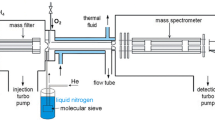Abstract
An animal chamber was constructed which made possible the exposure of small animals for long periods of time to uniform controlled atmospheres containing a given number of cluster ions.Monitoring of the microenvironment was made possible by the fabrication of a minaturized ion collector.Using these two developments mice were exposed to non-ionized or to positively ionized air containing either 2% or 4% CO2. Non-ionized 2% or 4% CO2 produced a fall in the blood level of 5-HT.Positively ionized 2% or 4% CO2 elicited a rise in 5-HT providing the ionic density was sufficiently great.
Zusammenfassung
Eine Kammer zur langfristigen Exponierung von kleinen Versuchstieren in einer kontrollierten Atmosphäre mit einer gegebenen Zahl Luftionen wird beschrieben. Die Ionen wurden mit einem Miniatur-Ionen-sammler gemessen. In der Kammer wurden Mäuse nicht-ionisierte und ionisierter Luft mit 2% und 4% CO2 exponiert. Nicht-ionisierterCO2 Zusatz von 2 und 4% führte zur Senkung des 5-Hydroxytryptamin (5-HT)-Spiegels im Blut, während positiv ionisierter CO2 Zusatz einen Anstieg des 5-HT im Blut bewirkte, wenn die Ionendichte genügend gross war.
Resume
On a construit une cellule dans laquelle on peut exposer de petits animaux durant de longues périodes à des atmosphères contrôlées, uniformes et contenant un nombre déterminé d'ions. Les ions ont été dénombrés au moyen d'un collecteur miniature. On a alors placé dans la dite cellule des souris qui furent exposées à de l'air ionisé et non-ionisé contenant 2 et 4% de CO2. L'adjonction de 2 et 4% de CO2 nonionisé à l'air a provoqué une baisse du taux de 5-HT dans le sang,alors que l'apport de CO2 ionisé positivement a provoqué une hausse du taux de 5-HT dans le sang pour autant que le nombre d'ions était suffisant.
Similar content being viewed by others
References
BERTLER, Å., ROSENGREN, A.M. and ROSENGREN, E. (1960): In vivo uptake of dopamine and 5-hydroxytryptamine by adrenal medullary granules.Experientia, 16: 418–419.
FREY, A.H. (1961): A rational framework for interpreting the behavioural effects of atmospheric ions. IRE Trans.Bio.Med.Electronics, 12–16.
FUERST, R. (1955): Annual Report. M.D.Anderson Hospital and Tumor Inst.,University of Texas, p. 60.
GELLHORN, E. (1953): The physiological foundation of neurology and psychiatry. University of Minnesota Press, Minneapolis, Minnesota.
KINGDON, K.H. (1960): Interaction of atmospheric ions with biological material. Physics Med.Biol., 5: 1–14.
KOTAKA, S., KRUEGER, A.P. and ANDRIESE, P.C. (1965): Some observations on air-ionenhanced iron chlorosis in barley(HORDEUM VULGARIS)seedlings. Plant and Cell Physiol. (Japan), 6: 233–245.
KOTAKA, S., KRUEGER, A.P., NISHIZAWA, K., OHUCHI, T., TAKENOBU, M., KOGURE, Y. and ANDRIESE, P.C. (1965): Air ion effects on the oxygen consumption of barley seedlings. Nature(Lond.), 208: 1112–1113.
KRUEGER, A.P. and SMITH, R.F. (1959): Parameters of gaseous ion effects on the mammalian trachea. J.gen.Physiol., 42: 959–969.
KRUEGER, A.P. and SMITH, R.F. (1960a): The biological mechanisms of air ion action. I. 5-Hydroxytryptamine as the endogenous mediator of positive air ion effects on the mammalian trachea. J. gen. Physiol., 43: 533–540.
KRUEGER, A.P. and SMITH, R.F. (1960b): The biological mechanisms of air ion action. II. Negative air ion effects on the concentration and metabolism of 5-hydroxytryptamine in the mammalian respiratory tract. J.gen.Physiol., 44: 269–276.
KRUEGER, A.P., ANDRIESE, P.C. and KOTAKA, S. (1963): The biological mechanism of air ion action: The effect of CO2 + in inhaled air on the blood level of 5-hydroxytryptamine in mice. Int. J.Biometeor., 7: 3–16.
KRUEGER, A.P., BECKETT, J.C., ANDRIESE, P.C. and KOTAKA, S. (1962): Studies on the effects of gaseous ions on plant growth.II.The construction and operation of an air purification unit for use in studies on the biological effects of gaseous ions.J.gen.Physiol., 45: 897–904.
KRUEGER, A.P., KOTAKA, S. and ANDRIESE, P.C. (1963): A study of the mechanism of airion-induced growth stimulation in HORDEUM VULGARIS. Int.J.Biometeor., 7: 17–25.
KRUEGER, A.P., KOTAKA, S. and ANDRIESE, P.C. (1964a): Studies on air-ion-enhanced iron chlorosis. I. Active and residual iron. J. Int.Biometeorol., 8: 5–16.
KRUEGER, A.P., KOTAKA, S. and ANDRIESE, P.C. (1964b): The effect of air containing O2 −, O2 +, CO2 −, and CO2 + on the growth of seedlings of HORDEUM VULGARIS. Int.J.Biometeor., 8: 17–25.
KRUEGER, A.P., KOTAKA, S. and ANDRIESE, P.C. (1965): Effect of abnormally low concentrations of air ions on the growth of HORDEUM VULGARIS. Int.J.Biometeor., 9 :
KRUEGER, A.P., SMITH, R.F. and GO, I.G. (1957): The action of air ions on bacteria. I. Protective and lethal effects on suspensions of staphylococci in droplets. J.gen.Physiol., 41: 359–381.
MEESEN, H. (1947): Organveränderungen nach experimenteller Kohlendioxyd-Vergiftung. Schweiz.med.Wschr., 77: 1135–1141.
PHILLIPS, G., HARRIS, G.J. and JONES, N.W. (1964): The effect of air ions on bacterial aerosols. Int.J.Biometeor., 8: 27–39.
PRATT, R. and BARNARD, R.W. (1960): Some effects of ionized air on penicillum notatum. Amer.Pharm.Assn., Scient, Edit., 49: 643–646.
SCHAEFER, K.E. (1959): Experiences with submarine atmospheres. J.Aviat.Med., 30: 350–359.
SCHAEFER, K.E. (ed.) (1962): Environmental effects of consciousness. Macmillan Co., New York, pp. 104.
SCHAEFER, K.E., STORR, H. and SCHEER, K. (1949): Über langdauernde Einwirkung verschieden hoher CO2-Konzentrationen auf Meerschweinchen. Pflügers Arch.ges.Physiol., 251: 741–764.
SMITH, R.F. and FULLER, W.H. (1961): Identification of a component of positively ionized air causing enhanced growth in plants. Plant Physiol., 36: 749–751.
SODEBERG, U. (1958): Short term reactions in the thyroid gland revealed by continuous measurements of blood flow,rate of uptake of radioactive iodine and rate of release of labeled hormones. Acta physiol.scand., 42: Suppl. 147, 5–113.
WORDEN, J.L. (1961): Proliferation of mammalian cells in ion-controlled environments. J.nat.Cancer Inst., 26: 801–811.
YEN, Y.C., CHANG, P.C., TSAI, H.S., YANG, Y.K. and SUN, J.Y. (1965): The effect of 5-hydroxytryptamine on adrenocortical function of rats. Acta physiol. sinica, 28: 309–312.
Author information
Authors and Affiliations
Additional information
With the technical assistance of Eddie J. Reed and S.M. Lamprecht.
Rights and permissions
About this article
Cite this article
Krueger, A.P., Andriese, P.C. & Kotaka, S. The effects of inhaling non-ionized or positively ionized air containing 2–4% CO2 on the blood levels of 5-hydroxytryptamine in mice. Int J Biometeorol 10, 17–28 (1966). https://doi.org/10.1007/BF01636117
Received:
Published:
Issue Date:
DOI: https://doi.org/10.1007/BF01636117




